Chesapeake Bay
| Chesapeake Bay | |
| Estuary | |
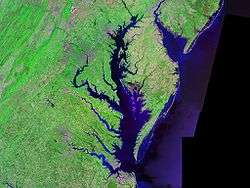 The Chesapeake Bay – Landsat photo | |
| Name origin: Chesepiooc, Algonquian for village "at a big river" | |
| Country | United States |
|---|---|
| States | Maryland, Virginia |
| Tributaries | |
| - left | Chester River, Choptank River, Nanticoke River, Pocomoke River |
| - right | Patapsco River, Patuxent River, Potomac River, Rappahannock River, York River, James River |
| Source | Susquehanna River mouth |
| - location | east of Havre de Grace, MD |
| - elevation | 0 ft (0 m) |
| - coordinates | 39°32′35″N 76°04′32″W / 39.54306°N 76.07556°W |
| Mouth | Atlantic Ocean |
| - location | north of Virginia Beach, VA |
| - elevation | 0 ft (0 m) |
| - coordinates | 36°59′45″N 75°57′34″W / 36.99583°N 75.95944°WCoordinates: 36°59′45″N 75°57′34″W / 36.99583°N 75.95944°W |
| Length | 200 mi (322 km) |
| Width | 30 mi (48 km) |
| Depth | 21 ft (6 m) |
| Basin | 64,299 sq mi (166,534 km2) |
| Area | 4,479 sq mi (11,601 km2) |
| Discharge | |
| - average | 78,300 cu ft/s (2,217 m3/s) [1] |
| - max | 389,000 cu ft/s (11,015 m3/s) |
| - min | 9,800 cu ft/s (278 m3/s) |
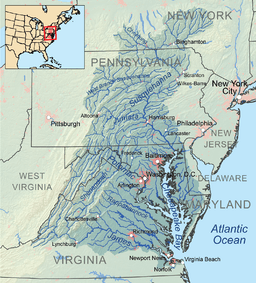 Chesapeake Bay Watershed
| |
| Designated | June 4, 1987 |
The Chesapeake Bay (/ˈtʃɛsəpiːk/ CHESS-ə-peek) is an estuary lying inland from the Atlantic Ocean, and surrounded by the North American mainland to the West, and the Delmarva Peninsula to the east. It is the largest such body in the contiguous US.[2] The northern bay is within Maryland, the southern portion within Virginia, and is a very important feature for the ecology and economy of those two states, as well as others. More than 150 major rivers and streams flow into the bay's 64,299-square-mile (166,534 km2) drainage basin, which covers parts of six states (New York, Pennsylvania, Delaware, Maryland, Virginia and West Virginia) plus all of the District of Columbia.[2][3]
The bay is approximately 200 miles (320 km) long from its northern headwaters in the Susquehanna River to its outlet in the Atlantic Ocean. It is 2.8 miles (4.5 km) wide at its narrowest (between Kent County's Plum Point near Newtown and the Harford County shore near Romney Creek) and 30 miles (48 km) at its widest (just south of the mouth of the Potomac River). Total shoreline including tributaries is 11,684 miles (18,804 km), circumnavigating a surface area of 4,479 square miles (11,601 km2). Average depth is 21 feet (6.4 m), reaching a maximum of 174 feet (53 m).[4] The bay is spanned twice, in Maryland by the Chesapeake Bay Bridge from Sandy Point (near Annapolis) to Kent Island and in Virginia by the Chesapeake Bay Bridge-Tunnel connecting Virginia Beach to Cape Charles. Known for both its beauty and bounty, the bay became "emptier", with fewer crabs, oysters and watermen in past years.[5] Recent restoration efforts begun in the 1990s have been ongoing and show potential for growth of the native oyster population.[6][7] The health of the Chesapeake Bay improved in 2015, marking three years of gains over the past four years, according to a new report by the University of Maryland.[8]
Etymology
The word Chesepiooc is an Algonquian word referring to a village "at a big river." It is the seventh oldest surviving English place-name in the U.S., first applied as "Chesepiook" by explorers heading north from the Roanoke Colony into a Chesapeake tributary in 1585 or 1586.[9] In 2005, Algonquian linguist Blair Rudes "helped to dispel one of the area's most widely held beliefs: that 'Chesapeake' means something like 'great shellfish bay.' It does not, Rudes said. The name might actually have meant something like 'great water,' or it might have just referred to a village location at the bay's mouth."[10] In addition, the name is almost always prefixed by "the" in usage by local residents: "The Chesapeake", "The Chesapeake Bay" and "The Bay".[11]
Physical geography
Geology and formation
The Chesapeake Bay is an estuary to the North Atlantic, lying between the Delmarva Peninsula to the east and the North American mainland to the west. It is the ria, or drowned valley, of the Susquehanna River, meaning that it was the alluvial plain where the river flowed when the sea level was lower. It is not a fjord, because the Laurentide Ice Sheet never reached as far south as the northernmost point on the bay. North of Baltimore, the western shore borders the hilly Piedmont region of Maryland; south of the city the bay lies within the state's low-lying coastal plain, with sedimentary cliffs to the west, and flat islands, winding creeks and marshes to the east. The large rivers entering the bay from the west have broad mouths and are extensions of the main ria for miles up the course of each river.
The bay's geology, its present form, and its very location were created by a bolide impact event at the end of the Eocene (about 35.5 million years ago), forming the Chesapeake Bay impact crater and the Susquehanna River valley much later. The bay was formed starting about 10,000 years ago when rising sea levels at the end of the last ice age flooded the Susquehanna River valley.[3] Parts of the bay, especially the Calvert County, Maryland, coastline, are lined by cliffs composed of deposits from receding waters millions of years ago. These cliffs, generally known as Calvert Cliffs, are famous for their fossils, especially fossilized shark teeth which are commonly found washed up on the beaches next to the cliffs. Scientists' Cliffs is a beach community in Calvert County named for the desire to create a retreat for scientists when the community was founded in 1935.[12]
Hydrology
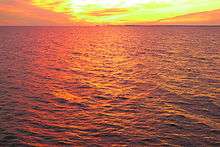
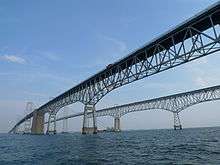
Much of the bay is shallow. At the point where the Susquehanna River flows into the bay, the average depth is 30 feet (9 m), although this soon diminishes to an average of 10 feet (3 m) southeast of the city of Havre de Grace, Maryland, to about 35 miles (56 km) just north of Annapolis. On average, the depth of the bay is 21 feet (6.4 m), including tributaries;[13] over 24 percent of the bay is less than 6 ft (2 m) deep.[14]
Because the bay is an estuary, it has fresh water, salt water and brackish water. Brackish water has three salinity zones: oligohaline, mesohaline, and polyhaline. The freshwater zone runs from the mouth of the Susquehanna River to north Baltimore. The oligohaline zone has very little salt. Salinity varies from 0.5 ppt to 10 ppt, and freshwater species can survive there. The north end of the oligohaline zone is north Baltimore and the south end is the Chesapeake Bay Bridge. The mesohaline zone has a medium amount of salt and runs from the Bay Bridge to the mouth of the Rappahannock River. Salinity there ranges from 10.7 ppt to 18 ppt. The polyhaline zone is the saltiest zone, and some of the water can be as salty as sea water. It runs from the mouth of the Rappahannock River to the mouth of the bay. The salinity ranges from 18.7 ppt to 36 ppt. (36 ppt is as salty as the ocean.)
The climate of the area surrounding the bay is primarily humid subtropical, with hot, very humid summers and cold to mild winters. Only the area around the mouth of the Susquehanna River is continental in nature, and the mouth of the Susquehanna River and the Susquehanna flats often freeze in winter. It is rare for the surface of the bay to freeze in winter, something which happened most recently in the winter of 1976–77.[15]
The largest rivers flowing directly into the bay, from north to south, are:
- Susquehanna River:
- Patapsco River;
- Chester River;
- Choptank River;
- Patuxent River;
- Nanticoke River;
- Potomac River;
- Pocomoke River;
- Rappahannock River;
- York River;
- James River.
Another river flowing into Chesapeake Bay is the Wicomico River, not to be confused with the tributary of the Potomac River.
Flora and fauna

The Chesapeake Bay is home to numerous fauna that either migrate to the bay at some point during the year or live there year round. There are over 300 species of fish and numerous shellfish and crab species. Some of these include the Atlantic menhaden, striped bass, American eel, eastern oyster, and the blue crab.[16]
Birds include osprey, great blue heron, bald eagle[17] and peregrine falcon, the last two of which were threatened by DDT; their numbers plummeted but have risen in recent years.[18] The piping plover is a near threatened species which inhabits the wetlands.[18]
Larger fish such as Atlantic sturgeon,[19] as well as varieties of sharks,[20][21] and stingrays visit the Chesapeake Bay.[22] In fact, waters of Chesapeake Bay have been regarded one of the most important nursery areas for sharks along east coasts.[23] Megafaunas such as bull sharks, tiger sharks, scalloped hammerhead sharks, and basking sharks[23] and manta rays are also known to visit.
Bottlenose dolphins are known to live seasonally/yearly the bay.[24] There are unconfirmed sightings of humpback whales in recent years.[25][26] Endangered North Atlantic right whale[27] and fin, and minke and sei whales have also been sighted within and vicinity to the bay.[22]
Chessie the manatee visited the bay repeatedly; this is further north of the manatee's usual habitat ranges.[28]
Loggerhead turtles[22] are known to visit the bay.
The Chesapeake Bay is also home to a diverse flora, both land and aquatic. Common submerged aquatic vegetation includes eelgrass and widgeon grass. A report in 2011 suggested that information on underwater grasses would be released, because "submerged grasses provide food and habitat for a number of species, adding oxygen to the water and improving water clarity."[29] Other vegetation that makes its home in other parts of the bay are wild rice, various trees like the red maple and bald cypress, and spartina grass and phragmites.[30] Invasive plants have taken a significant foothold in the Bay; including Brazilian waterweed (Egeria densa), native to South America, they have spread to most continents with the help of aquarium owners, who often dump the contents of their aquariums into nearby lakes and streams. It's highly invasive, and has the potential to flourish in the low-salinity tidal waters of the Chesapeake Bay. Dense stands of Brazilian waterweed can restrict water movement, trap sediment and affect water quality. Various local K-12 schools in the Maryland and Virginia region often have programs cultivate native bay grasses and plant them in the bay.
History
European exploration and settlement
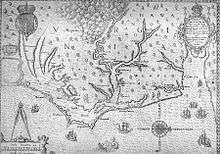
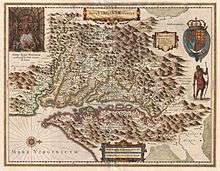
In 1524, Italian explorer Giovanni da Verrazzano, (1485–1528), in service of the French crown, (famous for sailing through and thereafter naming the entrance to New York Bay as the "Verrazzano Narrows", including now in the 20th century, a suspension bridge also named for him) sailed past the Chesapeake, but did not enter the bay.[33] Spanish explorer Lucas Vásquez de Ayllón sent an expedition out from Hispaniola in 1525 which reached the mouths of the Chesapeake and Delaware Bays. It may have been the first European expedition to explore parts of the Chesapeake Bay, which the Spaniards called "Bahía de Santa María" ("Bay of St. Mary")or "Bahía de Madre de Dios."("Bay of the Mother of God")[34] De Ayllón established a short-lived Spanish mission settlement, San Miguel de Gualdape, in 1526 along the Atlantic coast. Many scholars doubt the assertion that it was as far north as the Chesapeake; most place it in present-day Georgia's Sapelo Island.[35] In 1573, Pedro Menéndez de Márquez, the governor of Spanish Florida, conducted further exploration of the Chesapeake.[33] In 1570, Spanish Jesuits established the short-lived Ajacan Mission on one of the Chesapeake tributaries in present-day Virginia.
The arrival of English colonists under Sir Walter Raleigh and Humphrey Gilbert in the late 16th century to found a colony, later settled at Roanoke Island (off the present-day coast of North Carolina) for the Virginia Company, marked the first time that the English approached the gates to the Chesapeake Bay between the capes of Cape Charles and Cape Henry. Three decades later, in 1607, Europeans again entered the Bay. Captain John Smith of England explored and mapped the bay between 1607 and 1609, resulting in the publication in 1612 back in the British Isles of "A Map of Virginia".[36] Smith wrote in his journal: "Heaven and earth have never agreed better to frame a place for man's habitation."[37] The new laying out of the "Captain John Smith Chesapeake National Historic Trail", the United States' first designated "all-water" National Historic Trail, was created in July 2006, by the National Park Service of the U.S. Department of the Interior following the route of Smith's historic 17th-century voyage.[38] Because of economic hardships and civil strife in the "Mother Land", there was a mass migration of southern English Cavaliers and their servants to the Chesapeake Bay region between 1640 and 1675, to both of the new colonies of the Province of Virginia and the Province of Maryland.
American Revolution to the present
The Chesapeake Bay was the site of the Battle of the Chesapeake (also known as the "Battle of the Capes", Cape Charles and Cape Henry) in 1781, during which the French fleet defeated the Royal Navy in the decisive naval battle of the American Revolutionary War and enabling General George Washington along with his French allied armies under Comte de Rochambeau, marching down from New York to bottle up the rampaging southern British Army of Lord Cornwallis from the North and South Carolinas at the siege of Battle of Yorktown in Yorktown, Virginia. Their marching route from Newport, Rhode Island through Connecticut, New York State, Pennsylvania, New Jersey and Delaware to the "Head of Elk" by the Susquehanna River along the shores and also partially sailing down the Bay to Virginia (it is also the subject of another designated National Historic Trail under the National Park Service as the Washington-Rochambeau Revolutionary Route). It would again see conflict during War of 1812; During the year of 1813, from their base on Tangier Island, British naval forces under the command of Admiral George Cockburn raided and plundered several towns on the shores of the Chesapeake, treating the Bay as if it were a "British Lake". The Chesapeake Bay Flotilla, a fleet of shallow-draft armed barges under the command of U.S. Navy Commodore Joshua Barney, was assembled to stall British shore raids and attacks. After months of harassment by Barney, the British landed on the west side of the Patuxent at Benedict, Maryland, the Chesapeake Flotilla was scuttled, and the British trekked overland to burn the US Capitol in August 1814. A few days later in a "pincer attack", they also sailed up the Potomac River to attack Fort Washington below the National Capital and demanded a ransom from the nearby port town of Alexandria, Virginia.
There were so-called "Oyster Wars" in the late 19th and early 20th centuries. Until the mid-20th century, oyster harvesting rivaled the crab industry among Chesapeake watermen, a dwindling breed whose skipjacks and other workboats were supplanted by recreational craft in the latter part of the century.[39]
In the 1960s, the Calvert Cliffs Nuclear Power Plant on the historic Calvert Cliffs in Calvert County on the Western Shore of Maryland began using water from the Bay to cool its reactor.
Navigation
The Chesapeake Bay forms a link in the Intracoastal Waterway, of the bays, sounds and inlets between the off-shore barrier islands and the coastal mainland along the Atlantic coast connecting the Chesapeake and Delaware Canal (linking the Bay to the north and the Delaware River) with the Albemarle and Chesapeake Canal (linking the Bay, to the south, via the Elizabeth River, by the cities of Norfolk and Portsmouth to the Albemarle Sound and Pamlico Sound in North Carolina and further to the Sea Islands of Georgia). A busy shipping channel (dredged by the U.S. Army Corps of Engineers since the 1850s) runs the length of the Bay, is an important transit route for large container vessels entering or leaving the Port of Baltimore, and further north through the Chesapeake and Delaware Canal to the ports of Wilmington and Philadelphia on the Delaware River.
During the later half of the 19th century and first half of the 20th century, the Bay was plied by passenger steamships and packet boat lines connecting the various cities on it, notably the Baltimore Steam Packet Company ("Old Bay Line").
In the later 20th century, a series of road crossings were built. One, The Chesapeake Bay Bridge (also known as the Governor William Preston Lane Bridge) between the state capital of Annapolis, Maryland and Matapeake on the Eastern Shore, crossing Kent Island, constructed 1949-1952. The Chesapeake Bay Bridge-Tunnel, connecting Virginia's Eastern Shore with its mainland (at the metropolitan areas of Virginia Beach, Norfolk, Portsmouth, and Chesapeake), is approximately 20 miles (32 km) long; it has trestle bridges as well as two stretches of two-mile (3 km)-long tunnels which allow unimpeded shipping; the bridge is supported by four 5.25-acre (21,200 m2) man-made islands. The Chesapeake Bay Bridge-Tunnel was opened for two lanes in 1964 and four lanes in 1999.[40][41]
Tides
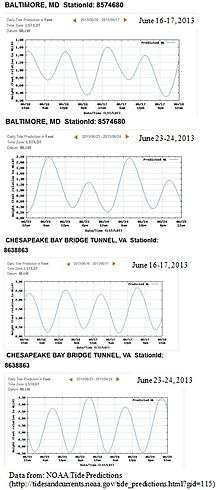
Tides in the Chesapeake Bay exhibit an interesting and unique behavior due to the nature of the topography (both horizontal and vertical shape), wind driven circulation, and how the Bay interacts with oceanic tides. Research into the peculiar behavior of tides both at the northern and southern extents of the Bay began in the late 1970s. One study noted sea level fluctuations at periods of 5 days, driven by sea level changes at the Bay’s mouth on the Atlantic coast and local lateral winds, and 2.5 days, caused by resonant oscillations driven by local longitudinal winds,[42] while another study later found that the geometry of the Bay permits for a resonant period of 1.46 days.[43]
A good example of how the different Chesapeake Bay sites experience different tides can be seen in the tidal predictions published by the National Oceanographic and Atmospheric Administration (NOAA) (see figure at right).
At the Chesapeake Bay Bridge Tunnel (CBBT) site, which lies at the southernmost point of the Bay where it meets the Atlantic Ocean near Norfolk, Virginia and the capes of Charles and Henry, there is a distinct semi-diurnal tide throughout the lunar month, with small amplitude modulations during spring (new/full moon) vs. neap (one/three quarter moon) tidal periods. The main forcing of the CBBT tides are typical, semi-diurnal ocean tides that the East Coast of the United States experiences.
Baltimore, in the northern portion of the Bay, experiences a noticeable modulation to form its mixed tidal nature during spring vs. neap tides. Spring tides, when the sun-earth-moon system forms a line, cause the largest tidal amplitudes during lunar monthly tidal variations. In contrast, neap tides, when the sun-earth-moon system forms a right angle, are muted, and in a semi-diurnal tidal system (such as that seen at the CBBT site) this can be seen as a lowest intertidal range.
Two interesting points that arise from comparing these two sites at opposite ends of the bay are their tidal characteristics - semi-diurnal tide for CBBT and mixed tide for Baltimore (due to resonance in the Bay) - and the differences in amplitude (due to dissipation in the Bay).
Economy
Fishing industry
The bay is mostly known for its seafood production, especially blue crabs,[44] clams and oysters. In the middle of the 20th century, the bay supported 9,000 full-time watermen, according to one account.[44] Today, the body of water is less productive than it used to be because of runoff from urban areas (mostly on the Western Shore) and farms (especially on the Eastern Shore and in the Susquehanna River watershed), over-harvesting, and invasion of foreign species.
The plentiful oyster harvests led to the development of the skipjack, the state boat of Maryland, which is the only remaining working boat type in the United States still under sail power. Other characteristic bay-area workboats include sail-powered boats such as the log canoe, the pungy, the bugeye, and the motorized Chesapeake Bay deadrise, the state boat of Virginia.[45]
In contrast to harvesting wild oysters, oyster farming is a growing industry for the bay to help maintain the estuary's productivity as well as a natural effort for filtering impurities such as excess nutrients from the water in an effort to reduce the effects of man-made pollution. The Chesapeake Bay Program is using oysters to reduce the amount of nitrogen compounds entering the Chesapeake Bay.[46]
Oysters are hermaphroditic and will change gender at least once during their lifetime, often starting as male and ending as female; there are numerous ways to cook and eat them, as well as recipes and sauces to accompany oyster dishes.[39] One account:
The Chesapeake oyster – sometimes called Chesapeake white gold – has a flavor and texture that begs connoisseurs to come back and shuck just a few more.
The bay is famous for its rockfish, a regional name for striped bass. Once on the verge of extinction, rockfish have made a significant comeback because of legislative action that put a moratorium on rockfishing, which allowed the species to re-populate. Rockfish are now able to be fished in strictly controlled and limited quantities.
Tourism and recreation
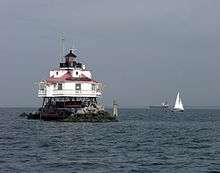
The Chesapeake Bay is a main feature for tourists who visit Maryland and Virginia each year. Fishing, crabbing, swimming, boating, kayaking,[17] and sailing are extremely popular activities enjoyed on the waters of the Chesapeake Bay. As a result, tourism has a notable impact on Maryland's economy[47] One report suggested that Annapolis was an appealing spot for families, water sports and boating.[48] Commentator Terry Smith spoke about the bay's beauty:
The water is glassy, smooth and gorgeous, his wake white against the deep blue. That's the problem with the Chesapeake. It's so damned beautiful.[37]
One account suggested how the Chesapeake attracts people:
You see them everywhere on Maryland's Eastern Shore, the weekend sailors. They are unmistakable with their deep tans, their baggy shorts, their frayed polo shirts, their Top-Siders worn without socks. Some may not even own their own boats, much less win regattas, but they are inexorably drawn to the Chesapeake Bay ... I planned to spend my days boating, eating as many Chesapeake Bay blue crabs as possible and making a little study of Eastern Shore locals. For city folk like me, they're interesting, even exotic –the weather-beaten crabbers and oystermen called "watermen," gentlemen-farmers and sharecroppers, boat builders, antiques dealers – all of whom sound like Southerners with mouthfuls of marbles when they talk. — Susan Spano, Los Angeles Times, 2008[49]
Environmental problems
Pollution and runoff

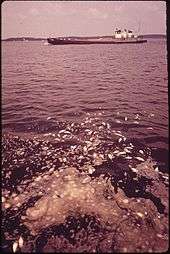
In the 1970s, the Chesapeake Bay was discovered to contain one of the planet's first identified marine dead zones, where waters were so depleted of oxygen that they were unable to support life, resulting in massive fish kills. Today the bay's dead zones are estimated to kill 75,000 tons of bottom-dwelling clams and worms each year, weakening the base of the estuary's food chain and robbing the blue crab in particular of a primary food source. Crabs are sometimes observed to amass on shore to escape pockets of oxygen-poor water, a behavior known as a "crab jubilee". Hypoxia results in part from large algal blooms, which are nourished by the runoff of residential, farm and industrial waste throughout the watershed. One report in 2010 criticized Amish farmers for having cows which "generate heaps of manure that easily washes into streams and flows onward into the Chesapeake Bay".[50]
_look_for_trash_on_the_shore_of_the_Chesapeake_Bay_during_Clean_The_Bay_Day.jpg)
The runoff and pollution have many components that help contribute to the algal bloom which is mainly fed by phosphorus and nitrogen.[51] This algae prevents sunlight from reaching the bottom of the bay while alive and deoxygenates the bay's water when it dies and rots. The erosion and runoff of sediment into the bay, exacerbated by devegetation, construction and the prevalence of pavement in urban and suburban areas, also blocks vital sunlight. The resulting loss of aquatic vegetation has depleted the habitat for much of the bay's animal life. Beds of eelgrass, the dominant variety in the southern bay, have shrunk by more than half there since the early 1970s. Overharvesting, pollution, sedimentation and disease have turned much of the bay's bottom into a muddy wasteland.[52]
One particularly harmful source of toxicity is Pfiesteria piscicida, which can affect both fish and humans. Pfiesteria caused a small regional panic in the late 1990s when a series of large blooms started killing large numbers of fish while giving swimmers mysterious rashes, and nutrient runoff from chicken farms was blamed for the growth.[53]
The bay improved slightly in terms of the overall health of its ecosystem, earning a rating of 31 out of 100 in 2010, up from 28 in 2008.[2] An estimate in 2006 from a "blue ribbon panel" said cleanup costs would be $15 billion.[37] Compounding the problem is that 100,000 new residents move to the area each year.[37] A report in 2008 in the Washington Post suggested that government administrators had overstated progress on cleanup efforts as a way to "preserve the flow of federal and state money to the project."[54] In January 2011, there were reports that millions of fish had died, but officials suggested it was probably the result of extremely cold weather.[55]
Depletion of oysters
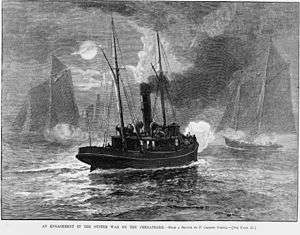
While the bay's salinity is ideal for oysters and the oyster fishery was at one time the bay's most commercially viable,[56] the population has in the last fifty years been devastated. Maryland once had roughly 200,000 acres (810 km2) of oyster reefs. Today it has about 36,000.[56] It has been estimated that in pre-colonial times, oysters could filter the entirety of the bay in about 3.3 days; by 1988 this time had increased to 325 days.[57] The harvest's gross value decreased 88% from 1982 to 2007.[58] One report suggested the bay had fewer oysters in 2008 than 25 years earlier.[5]

The primary problem is overharvesting. Lax government regulations allow anyone with a license to remove oysters from state-owned beds, and although limits are set, they are not strongly enforced.[56] The overharvesting of oysters has made it difficult for them to reproduce, which requires close proximity to one another. A second cause for the oyster depletion is that the drastic increase in human population caused a sharp increase in pollution flowing into the bay.[56] The bay's oyster industry has also suffered from two diseases: MSX and Dermo.[59]
The depletion of oysters has had a particularly harmful effect on the quality of the bay. Oysters serve as natural water filters, and their decline has further reduced the water quality of the bay. Water that was once clear for meters is now so turbid that a wader may lose sight of their feet before their knees are wet.
Efforts of federal, state and local governments, working in partnership through the Chesapeake Bay Program, and the Chesapeake Bay Foundation and other nonprofit environmental groups, to restore or at least maintain the current water quality have had mixed results. One particular obstacle to cleaning up the bay is that much of the polluting substances arise far upstream in tributaries lying within states far removed from the bay. Despite the state of Maryland spending over $100 million to restore the bay, conditions have continued to grow worse. Twenty years ago, the bay supported over six thousand oystermen. There are now fewer than 500.[60]
Efforts to repopulate the bay via hatcheries have been carried out by a group called the Oyster Recovery Partnership, with some success. They recently placed 6 million oysters on 8 acres (32,000 m2) of the Trent Hall sanctuary.[61] Scientists from the Virginia Institute of Marine Science at the College of William & Mary claim that experimental reefs created in 2004 now house 180 million native oysters, Crassostrea virginica, which is far fewer than the billions that once existed.[62]
Publications
There are several magazines and publications that cover topics directly related to the Chesapeake Bay and life and tourism within the bay region.
The Capital, a newspaper based in Annapolis, reports about news pertaining to the Western Shore of Maryland and the Annapolis area.[63] Chesapeake Bay Magazine and PropTalk focus on powerboating while SpinSheet focuses on sailing.[64][65][66]
Cultural depictions
In literature
- Beautiful Swimmers: Watermen, Crabs and the Chesapeake Bay (1976) is a Pulitzer Prize winning non-fiction book by William W. Warner about the Chesapeake Bay, blue crabs and watermen.
- Chesapeake, a 1978 novel by author James A. Michener
- John Barth's 1982 Sabbatical: A Romance, a novel centered on a yacht race through the Chesapeake Bay
- John Barth's 1987 The Tidewater Tales, a novel in which a married couple tell stories to each other as they cruise the bay.
- Jacob Have I Loved (1980) by Katherine Paterson, winner of the 1981 Newbery Medal. This is a novel about the relationship between two sisters in a waterman family who grow up on an island in the Bay.
- In Tom Clancy's 1987 book Patriot Games, the main protagonist Jack Ryan lives on the fictional Peregrine Cliffs which overlook the Chesapeake Bay.
In film
- The Bay (film), a 2012 found footage style eco-horror movie about a pandemic due to deadly pollution from chicken factory farm run-off and mutant isopods and aquatic parasites able to infect humans.
Other media
Singer and songwriter Tom Wisner recorded several albums, often about the Chesapeake Bay. The Boston Globe wrote that Wisner "always tried to capture the voice of the water and the sky, of the rocks and the trees, of the fish and the birds, of the gods of nature he believed still watched over it all."[67] He was known as the Bard of the Chesapeake Bay.[67]
The 1976 hit "Moonlight Feels Right" by Starbuck refers to Chesapeake Bay: "I'll take you on a trip beside the ocean / And drop the top at Chesapeake Bay."
See also
- Chesapeake Bay Interpretive Buoy System
- Chesapeake Bay Retriever
- Chesapeake Climate Action Network
- Chesepian
- Chessie (sea monster)
- Coastal and Estuarine Research Federation
- Dead zone (ecology)
- Delmarva Peninsula
- Great Ireland
- List of islands in Maryland (with the islands in the bay)
- National Estuarine Research Reserve
- Old Bay Seasoning
References
- ↑ "Estimated Streamflow Entering Chesapeake Bay". ME-DE-DC Water Science Center. U.S. Geological Survey. 2011-05-05. Retrieved 2011-05-06.
- 1 2 3 Leslie kaufman (December 28, 2010). "More Blue Crabs, but Chesapeake Bay Is Still at Risk, Report Says". The New York Times. Retrieved 2011-04-20.
- 1 2 "Fact Sheet 102-98 – The Chesapeake Bay: Geologic Product of Rising Sea Level". U. S. Geological Survey. 1998-11-18. Retrieved 2008-01-13.
- ↑ "Chesapeake Bay, VA/MD (M130) Bathymetric Digital ElevationModel (30 meter resolution) Derived From Source Hydrographic Survey Soundings Collected by NOAA". National Oceanic and Atmospheric Administration. 2013-05-17. Archived from the original on 2015-01-22. Retrieved 2015-01-21.
- 1 2 David A. Fahrenthold (December 28, 2008). "Way of Life Slipping Away Along Chesapeake's Edge". Washington Post. Retrieved 2011-04-20.
- ↑ "Signs of a Chesapeake Bay oyster comeback". 19 November 2013 – via washingtonpost.com.
- ↑ Kuebler, Brian (1 February 2015). "Maryland oysters making a comeback".
- ↑ "Report: Chesapeake Bay at healthiest level in years".
- ↑ Also shown as "Chisupioc" (by John Smith) and "Chisapeack", in Algonquian "che" means "big" or "great", "sepi" means river, and the "oc" or "ok" ending indicated something (a village, in this case) "at" that feature. "Sepi" is also found in another placename of Algonquian origin, Mississippi. The name was soon transferred by the English from the big river and the village at that site to the entire bay. Stewart, George (1945). Names on the Land: A Historical Account of Place-Naming in the United States. New York: Random House. p. 23.
- ↑ Farenthold, David A. (2006-12-12). "A Dead Indian Language Is Brought Back to Life". The Washington Post. p. A1. Retrieved 2007-03-19.
- ↑ Program, Chesapeake Bay. "Facts & Figures - Chesapeake Bay Program".
- ↑ "FAQ". Scientists Cliffs community. Archived from the original on January 7, 2009. Retrieved 2008-05-08.
- ↑ "Geography". Chesapeake Bay Foundation. Archived from the original on October 14, 2007. Retrieved 2008-04-21. Other sources give values of 25 feet (e.g. "Charting the Chesapeake 1590-1990". Maryland State Archives. Retrieved 2008-04-21.) or 30 feet (9.1 m) deep ("Healthy Chesapeake Waterways" (PDF). University of Maryland Center for Environmental Science. Archived from the original (PDF) on 2008-06-26. Retrieved 2008-04-21.)
- ↑ "Chesapeake Bay Program: A Watershed Partnership: Facts & Figures". chesapeakebay.net (Chesapeake Bay Program Office). 2010-05-04. Retrieved 2010-10-29.
- ↑ "The Big Freeze". Time. 1977-01-31. Retrieved 2007-03-19.
- ↑ A Comprehensive List of Chesapeake Bay Basin Species. Annapolis, MD: Chesapeake Bay Program. 2007. Retrieved 11 October 2015.
- 1 2 Elton Dunn, Demand Media (2011-04-20). "Chesapeake Bay Kayak Tours". USA Today. Retrieved 2011-04-20.
- 1 2 Blankenship, Karl (September 1995). "Endangered Species Around the Chesapeake". 5 (6).
- ↑ "Atlantic Sturgeon". Chesapeake Bay Program. Retrieved December 21, 2014.
- ↑ The Chesapeake Bay News. 2010. Are there sharks in the Chesapeake Bay?. Retrieved on December 21. 2014
- ↑ Shinkman D.P.. Sharks in the Chesapeake: More likely than thought. The WTOP-FM. Retrieved on December 21. 2014
- 1 2 3 Lippson J.A., Lippson L.R. (2006), Life in the Chesapeake Bay, Johns Hopkins University Press, pp. 275–281, retrieved 2014-12-21 pages=275–281 at the Wayback Machine (archived December 21, 2014)
- 1 2 The National Aquarium. Sharks Among Us: Chesapeake Bay Species. Retrieved on December 22. 2014
- ↑ "Bottlenose Dolphin". Chesapeake Bay Program. Retrieved December 21, 2014.
- ↑ O'BRIEN D.. 1992. Whale in Chesapeake Provides Reminders About Nature. The Baltimore Sun. Retrieved on December 21. 2014
- ↑ The Southside Sentinel. 2010. Whale sighted in the Chesapeake Bay. Retrieved on December 21. 2014
- ↑ National Oceanic and Atmospheric Administration. 2010. NOAA: Ship Speed Restrictions to Protect Endangered North Atlantic Right Whales. Retrieved on December 22. 2014
- ↑ "Four rare Chesapeake Bay "oddities" to learn about this leap year". The Chesapeake Bay News. February 27, 2012. Retrieved December 21, 2014.
- ↑ "Chesapeake Bay Program to release new data on underwater grasses in bay, rivers". Washington Post. Associated Press. April 20, 2011. Retrieved 2011-04-20.
- ↑ Domes S., Lewis M., Moran R., Nyman D.. “Chesapeake Bay Wetlands”. Emporia State University. May 2009. Retrieved 2010-03-14.
- ↑ orientation of map depicts west at top
- ↑ Woodard, Buck (2006-11-22). COLONIAL A Study of Virginia Indians and Jamestown: The First Century. Washington, DC: National Park Service. p. APPENDIX A. Retrieved 9 April 2016.
- 1 2 Parramore, Thomas (2000). Norfolk: The First Four Centuries. pp. 1–16. Retrieved 2011-11-05.
- ↑ Grymes, Charles A. "Spanish in the Chesapeake". Retrieved 2010-07-08.
- ↑ Weber, David (1994). The Spanish Frontier in North America. New Haven, CT: Yale University Press. pp. 36, 37.
- ↑ "Smith's Maps". Captain John Smith Chesapeake National Historical Trail. National Park Service. Retrieved 12 June 2012.
- 1 2 3 4 Terry Smith (commentator), Michele Norris (host) (April 13, 2006). "The Chesapeake Bay, Scenic and Unhealthy". NPR. Retrieved 2011-04-20.
- ↑ "H.R. 5466 [109th] Captain John Smith Chesapeake National Historic Trail Designation Act". GovTrack.us. Retrieved December 16, 2007.
- 1 2 3 Morris, Kendra Bailey (November 21, 2007). "Consider the Chesapeake Bay Oyster". NPR. Retrieved April 20, 2011.
- ↑ "CBBT Facts".
- ↑ Wollf, J.D. (April 20, 2011). "Fishing at the Chesapeake Bay Bridge Tunnel". USA Today. Retrieved April 20, 2011.
- ↑ Wang, D.-P. 1979. Subtidal Sea Level Variations in the Chesapeake Bay and Relations to Atmospheric Forcing. Journal of Physical Oceanography. Vol. 9. pp. 413–421.
- ↑ Wang, D-P. and A.J. Elliott. Non-Tidal Variability in the Chesapeake Bay and Potomac River: Evidence for Non-Local Forcing. Journal of Physical Oceanography. Vol. 8. pp. 225–232.
- 1 2 Grimes, William (April 30, 2008). "William W. Warner, Chesapeake Bay Author, Dies at 88". New York Times. Retrieved April 20, 2011.
- ↑ "Chesapeake Bay Workboats". Chesapeake Bay Gateway Network. Retrieved 2007-03-19.
- ↑ Department of Natural Resources. "Oyster Restoration Projected to Provide Significant Boost to Bay Grasses While Removing Nitrogen Pollution from the Bay". Maryland.
- ↑ Harvey M. Katz (2009-08-27). "Chesapeake Bay Executive Order | Targeting Resources to Better Protect the Chesapeake Bay is Aim of U.S. Department of Agriculture's 202(b) Report". Executiveorder.chesapeakebay.net. Retrieved 2014-02-28.
- ↑ Anne glusker (October 9, 2005). "A Treasure Chest of Fun on Chesapeake Bay". The New York Times. Retrieved 2011-04-20.
- ↑ Susan spano (June 23, 2002). "Peak Season on Chesapeake Bay". Los Angeles Times. Retrieved 2011-04-20.
- ↑ Sindya n. bhanoo (June 8, 2010). "Amish Farming Draws Rare Government Scrutiny". The New York Times. Retrieved 2011-04-20.
- ↑ Dennen, R. (2009-10-30). "Is it time we put the ailing Bay on diet?". The Free Lance Star. Retrieved 2010-02-17
- ↑ "Bad Water and the Decline of Blue Crabs in the Chesapeake Bay". Chesapeake Bay Foundation. December 2008. Retrieved 2009-01-21.
- ↑ Fahrenthold, David A. (2008-09-12). "Md. Gets Tough on Chicken Farmers". Washington Post.
- ↑ David A. Fahrenthold (December 27, 2008). "Failing the Chesapeake Bay – Broken Promises on the Bay". Washington Post. Retrieved 2011-04-20.
- ↑ "Two Million Dead Fish Appear in Chesapeake Bay". CBS News. Jan 5, 2011. Retrieved 2011-04-20.
- 1 2 3 4 Oysters: Gem of the Ocean, The Economist, December 8, 2008; accessed September 2, 2009.
- ↑ "Oyster Reefs: Ecological importance". US National Oceanic and Atmospheric Administration. Archived from the original on October 3, 2008. Retrieved 2007-11-06.
- ↑ "Estimating Net Present Value in the Northern Chesapeake Bay Oyster Fishery" (PDF). NOAA Chesapeake Bay Office. 2008-11-07. Archived from the original (PDF) on June 29, 2009. Retrieved 2009-09-08.
- ↑ "Research – Shellfish Diseases". Virginia Institute of Marine Science. 2007-03-16. Archived from the original on February 11, 2007. Retrieved 2008-02-22.
- ↑ Urbina, Ian (November 29, 2008). "In Maryland, Focus on Poultry Industry Pollution". The New York Times: A14.
- ↑ Program turns pork into oysters, Jesse Yeatman, South Maryland Newspapers Online, August 12, 2009.
- ↑ Oysters Are on the Rebound in the Chesapeake Bay, Henry Fountain, The New York Times, August 3, 2009; accessed September 8, 2009.
- ↑ "Top Stories". The Capital Newspaper. Capital Gazette Communications. Archived from the original on February 8, 2009. Retrieved April 22, 2011.
- ↑ "Chesapeake Bay Magazine". Retrieved April 22, 2011.
- ↑ "PropTalk". PropTalk Media LLC. Retrieved April 22, 2011.
- ↑ "SpinSheet". SpinSheet Publishing Co. Retrieved April 22, 2011.
- 1 2 Jenna Johnson (April 9, 2010). "Tom Wisner; Chesapeake Bay served as bard's muse; at 79". Boston Globe. Retrieved 2011-04-20.
Further reading
- Cleaves, E.T. et al. (2006). Quaternary geologic map of the Chesapeake Bay 4º x 6º quadrangle, United States [Miscellaneous Investigations Series; Map I-1420 (NJ-18)]. Reston, VA: U.S. Department of the Interior, U.S. Geological Survey.
- Crawford, S. 2012. Terrapin Bay Fishing. Chesapeake Bay Tides and Currents
- Meyers, Debra and Perrealt, Melanie (eds.) (2014). Order and Civility in the Early Modern Chesapeake. Lanham, MD: Rowman and Littlefield.
- Phillips, S.W., ed. (2007). Synthesis of U.S. Geological Survey science for the Chesapeake Bay ecosystem and implications for environmental management [U.S. Geological Survey Circular 1316]. Reston, VA: U.S. Department of the Interior, U.S. Geological Survey.
- Thomas, William G., III. "The Chesapeake Bay." Southern Spaces, April 16, 2004.
- William W. Warner, Beautiful Swimmers, about the history, ecology and anthropology of the Chesapeake Bay, published 1976
External links
| Wikivoyage has a travel guide for Chesapeake Bay. |
| Wikimedia Commons has media related to Chesapeake Bay. |
- National Geographic – Saving The Chesapeake
- National Geographic – Exploring The Chesapeake Then and Now
- Captain John Smith Chesapeake National Historic Water Trail.
- University of Maryland Center for Environmental Science Research and science application activities emphasizing Chesapeake Bay and its watershed.
- Maryland Department of Natural Resources Eyes on the Bay Real-time and historical Chesapeake Bay water quality and satellite data.